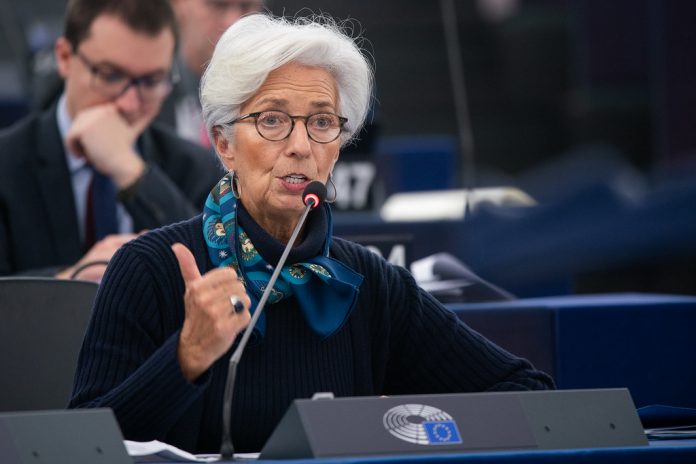
By Belgian MEP Johan Van Overtveldt (Belgian Finance Minister between 2014 and 2018, Chairman of the European Parliament’s Budget Committee)
In just one year, the ECB has halved its main policy interest rate. Can such decisive action be justified by the trajectory of inflation alone? It is evident that other factors are also influencing the ECB’s policy path.
On 5 June, the European Central Bank (ECB) reduced its three key interest rates—the main refinancing operations rate, the marginal lending facility rate, and most notably, the deposit facility rate—by 25 basis points, bringing the deposit rate to 2%. This eighth rate cut since June 2024 means that the ECB has halved its base policy rate from 4% to 2% within a year. The deposit rate had peaked at 4% in September 2023 and remained there for nine months.
Confronted with surging inflation, the ECB spent four years (from September 2019 to September 2023) tightening monetary policy, raising the deposit facility rate from –0.5% to 4%. It then took just one year (from June 2024 to June 2025) to lower the base rate from 4% to 2%. Although the upward move was more than twice as large as the downward one, the speed of the latter suggests a significantly faster pace of policy easing.
In April, ECB President Christine Lagarde stated that “most measures of underlying inflation” indicated the ECB was on track to meet its 2% inflation target “on a sustained basis.” This relatively benign inflation outlook, combined with heightened economic uncertainty—largely driven by the trade wars unleashed by US President Donald Trump—provides the main rationale behind the ECB’s sharp policy reversal. Yet, several pertinent questions and concerns about the ECB’s current course remain.
OOPS! #ECB deposit rate has fallen below the German inflation rate for the first time since September 2023. pic.twitter.com/NIhAKj1IZI
— Holger Zschaepitz (@Schuldensuehner) June 5, 2025
Below Par
Let us begin by comparing the ECB’s policy rate decisions with the evolution of eurozone inflation. Headline inflation, which peaked at 10.6% in October 2022, has since fallen considerably. At the start of 2025, it stood at 2.5%, and in May the annualised rate had reached 1.9%, according to Eurostat’s flash estimate. The ECB’s medium-term inflation target is 2%. Core inflation—which excludes the volatile energy and food components—stood at 2.3% in May, down from 2.7% at the beginning of the year. Service sector inflation was 3.5% in May, compared to 3.9% earlier in the year.
While the decline in overall inflation is certainly welcome, core and particularly service inflation remain above target. The ECB’s assertion—based on its macroeconomic models—that it is on track to sustainably achieve its 2% inflation target should be taken with a pinch of salt. These models have historically underperformed when it comes to forecasting inflation. That is, in fact, a charitable assessment of their record.
“The ECB’s assertion that it is on track to meet the 2% target ‘on a sustainable basis’ should be taken with a pinch of salt.”
It may well be the case that the impact of lower oil and energy prices, along with a stronger euro, has not yet been fully reflected in inflation data. Slower economic growth—or even recession—would also reduce price pressures. Further easing of inflation is certainly possible. However, opposing forces should not be overlooked. For one, wage growth remains robust and clearly outpaces inflation. Wages in the eurozone rose by 4.5% in 2024—the highest annual increase since 1993. For 2025, wage growth is expected at 3.6%, still significantly higher than both inflation and productivity growth.
Secondly, the inflationary effects of the ongoing tariff escalation should not be underestimated. Trump’s trade war has triggered widespread efforts to reconfigure international supply chains, a process that is likely to drive up prices across a broad spectrum of goods and services. Upcoming inflation data will shed more light on the direction of travel, but we can be fairly certain: uncertainty around inflation and growth will persist—if not increase. In such an environment, a more cautious monetary stance might be advisable.
Considering all of the above, it is entirely legitimate to ask whether the ECB has been too hasty in reducing rates. Real interest rates (nominal policy rates minus inflation) are now effectively zero relative to headline inflation, negative relative to core inflation, and deeply negative when compared with service sector inflation. In modern economies such as the eurozone’s, the service sector accounts for between 65% and 75% of GDP. Persistently negative real interest rates erode the value of savings, encourage speculative financial activity, and increase the likelihood of inflation resurfacing.
“It is entirely legitimate to ask whether the ECB has been too hasty in reducing policy rates.”
A Transatlantic Comparison
It is instructive to compare the ECB’s recent rate path with that of the US Federal Reserve. Also grappling with rapidly rising inflation, the Fed raised its key federal funds rate from 0.25% in early 2022 to 5.5% by July 2023, maintaining that level until August 2024. Like the ECB, the Fed then began cutting rates, reaching a range of 4.25–4.50% by December 2024. Unlike the ECB, however, it has since paused.
With headline inflation at 2.3%, core inflation at 2.8%, and services inflation at 3.7%, the United States currently maintains real interest rates firmly in positive territory. Given the continued resilience of the American economy (though some recent data point to a slowdown), tight labour markets, and the inflationary risks associated with Trump’s tariff agenda, there are solid reasons for the Fed to keep real interest rates above zero. It is noteworthy that Fed Chair Jerome Powell and his committee have stuck to this policy, despite open criticism from President Trump.
The Unspoken Motives
My conclusion is this: the Fed’s case for maintaining positive real interest rates is far stronger than the ECB’s case for pushing real rates to zero—or even below. The argument that such a move is necessary to support fragile growth in the eurozone and to counter Trump-induced uncertainty is unconvincing. Would a 2% nominal policy rate make a meaningful difference compared to, say, 2.5%? To answer yes is to overestimate the impact of monetary policy on growth and uncertainty, while underestimating its role in controlling medium-term inflation. It also ignores the well-documented unintended consequences of ultra-low interest rates.
Why then has the ECB opted to lower rates so sharply? I see three reasons that ECB policymakers have not openly acknowledged.
First, lower eurozone interest rates help stem the euro’s appreciation—especially against the US dollar, which remains the world’s dominant currency. Since Trump’s election, the euro has appreciated by around 10% (from roughly $1.05 to $1.15). This revaluation places a heavy burden on eurozone exporters and dampens corporate profitability.
Second, higher interest rates create pressure to de-leverage, especially among heavily indebted actors. Rapid and intense de-leveraging can depress asset prices and undermine the balance sheets of companies and financial institutions, posing risks to financial stability. Lower rates alleviate this pressure.
Third, several eurozone governments—notably France and Italy, the second- and third-largest economies in the bloc—are grappling with high budget deficits and rising debt levels. Higher interest rates worsen these fiscal challenges. Lower rates offer temporary relief.
“The more central banks signal their willingness to intervene, the weaker governments’ incentives become to reform public finances and implement structural reforms.”
The ECB remains silent on the exchange rate issue, likely to avoid opening a debate about its mandate. On the other two issues—de-leveraging and public finances—one must ask whether the ECB is sacrificing long-term stability for uncertain short-term gains. The more signals governments receive that central banks will provide support, the weaker their motivation to consolidate public finances and undertake necessary structural reforms.
A Note of Humility
Let me end with a note of humility. First, formulating monetary policy in today’s environment is an exceptionally difficult task. The geopolitical, economic, and financial uncertainties are immense, with little sign of easing. Anyone criticising the course taken by a central bank such as the ECB must acknowledge that no one has a crystal ball. Numerous variables remain in flux. I am acutely aware of this, and I urge readers to keep this in mind when reading my analysis.
Second, my criticisms should in no way be interpreted as a call to challenge the ECB’s independence. Absolutely not. A central bank under the direct control of politicians would be disastrous. History shows that when political leaders gain control of the printing press, the result is invariably economic turmoil. Independence remains the cornerstone of credible monetary policy.
Originally published on Johan Van Overtveldt’s blog
Disclaimer: www.BrusselsReport.eu will under no circumstance be held legally responsible or liable for the content of any article appearing on the website, as only the author of an article is legally responsible for that, also in accordance with the terms of use.












